White Sun Spots on Skin
Symptoms, Causes, Treatment, and More
Medically reviewed by William Truswell, MDMedically reviewed by William Truswell, MD
Sun exposure and tanning can lead to white sun spots on the skin. The presence of white sun spots on the skin is clinically known as idiopathic guttate hypomelanosis (IGH). IGH is a benign skin condition considered a cosmetic problem. IGH can affect all skin tones.
These white sun spots are a form of hypopigmentation or a lack of melanin in the affected skin area. Melanin is a substance in the body that determines eye, skin, and hair color. The more melanin produced, the darker the eyes, skin, and hair.
It is unknown why some people get IGH, but researchers believe it is due to a decline in melanin production caused by UV exposure, aging, or genetics.
IGH spots often appear on the arms, legs, trunk, and face. They do not cause itching or pain. Treatment can reduce the appearance of white spots and may include topical creams and professional treatments.
This article will cover the signs and symptoms of white sun spots, causes and risk factors, treatment, and more.
Signs and Symptoms of White Sun Spots on Skin
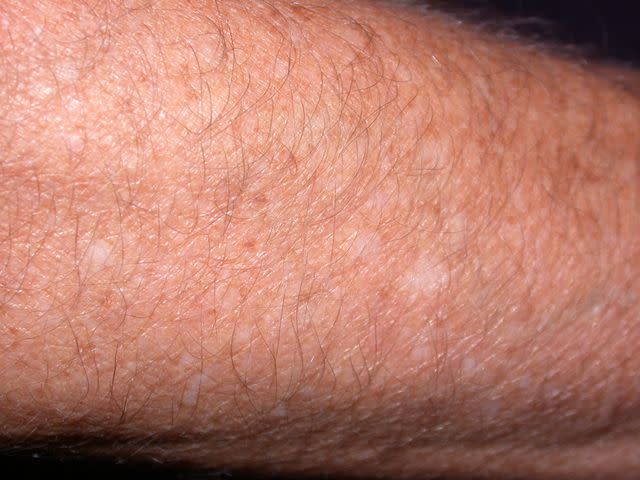
Reproduced with permission from © DermNet dermnetnz.org 2023.
Sun spots are white spots on the skin where skin pigment has been lost. These spots usually cause no symptoms.
The size of skin lesions can vary from 1 to 10 millimeters (mm), but most are about 1 to 3 mm in size. Sun spots first appear on the legs and progress to the arms, upper body, and face. They present as irregular shapes with uneven borders.
IGH skin spots can affect people of all races and skin tones. They tend to occur more frequently in people with lighter skin types. White sun spots tend to stand out more on darker skin.
Related: How White Spots on Skin Look in Pictures
Causes and Risk Factors of White Sun Spots on Skin
Researchers have not yet established a definitive cause of IGH. The most commonly accepted cause is a disruption in melanin production caused by ultraviolet (UV) damage from sun exposure and tanning over time.
The link to sun exposure is based on the idea that these spots appear in body areas exposed to the sun—the arms, legs, face, and upper back.
Additional research suggests that white sun spots are part of the natural aging process. IGH usually affects people age 40 and up, and your risk for the condition increases with age.
Genetics might also predispose some people to IGH, and the condition can run in families. Additional causes include skin trauma, autoimmunity, and local inhibition of the melanin process.
What Other Conditions Cause White Spots on Skin?
Other skin conditions can lead to white spots on the skin. Such conditions include:
Pityriasis alba
Tinea versicolor
Vitiligo
Milia
Pityriasis Alba
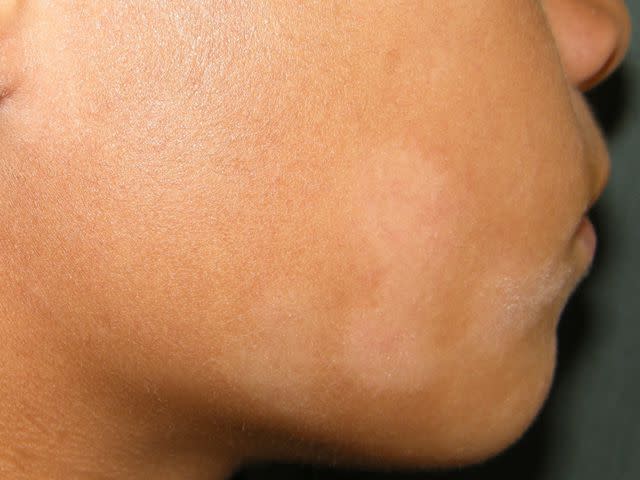
Pityriasis alba is a skin condition that causes spots that are lighter in color than the surrounding skin or white. Skin lesions start as scaly oval or round patches that can be discolored or red and appear on the face, neck, upper arms, and trunk. Once the lesions heal, they turn light-colored or white.
Tinea Versicolor
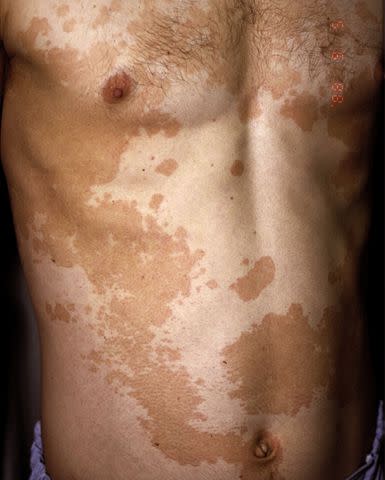
Reproduced with permission from ©DermNet NZ www.dermnetnz.org 2022.
Tinea versicolor is a common fungal skin infection that causes light and dark patches of skin. The patches can appear white, pink, or reddish brown. Tinea versicolor often appears on the chest or back.
Due to their oily skin, it mainly affects children, teens, and young adults, but it can also affect anyone at any age. Treatment includes antifungal and anti-dandruff shampoos, antifungal creams, and oral antifungal medicines.
Vitiligo
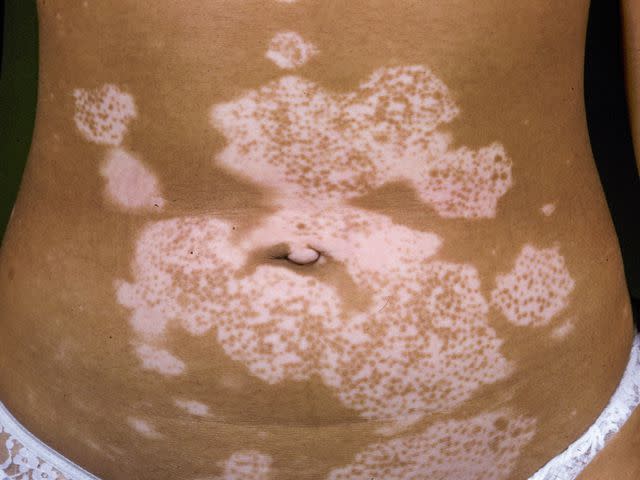
Reproduced with permission from © DermNet and © Dr Richard Ashton dermnetnz.org 2023.
Vitiligo is an autoimmune skin condition that occurs when immune system cells target melanocytes, which are responsible for creating skin pigment. Disrupted pigment production causes affected skin areas to appear white. Vitiligo is not painful but causes lighter skin areas vulnerable to sunburn.
Skin patches will appear on the hands, feet, arms, face, and genitals. Vitiligo also causes hair on the scalp, eyebrows, eyelashes, beard, and body to turn white.
Because the body’s inflammatory response causes vitiligo, it is treated with topical steroids. Oral medications and skin therapy treatments are used to treat severe causes.
Milia
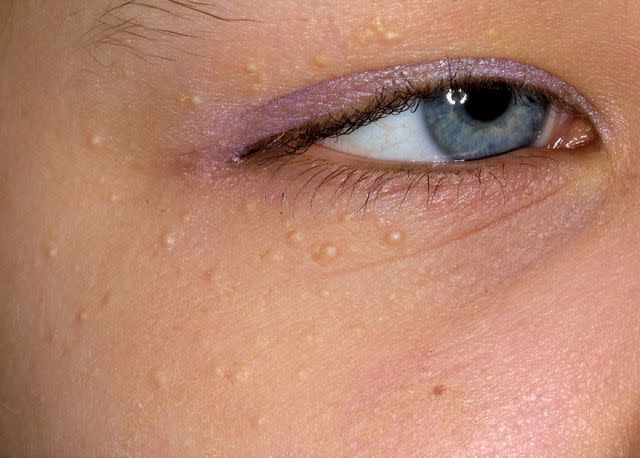
Reproduced with permission from © DermNet and © Raimo Suhonen dermnetnz.org 2023.
Milia are tiny bumps that appear on the cheeks, nose, or eyelids. They might also present on other skin areas. Milia are painless, fluid-filled sacs that can be white, yellowish, or the same color as the person's skin.
Milia occur when keratin becomes trapped under the skin, causing fluid-filled bumps. Keratin is a protein that helps to harden the skin’s outer layer. Causes of milia include skin damage, corticosteroid use, and genetic or autoimmune diseases.
Babies with milia usually do not need treatment, but it is vital to keep the skin clean. Adults with milia can treat it with exfoliators, retinol skincare products, or facial peels. Severe milia is treated with cryotherapy, laser surgery, chemical peels, dermabrasion, topical creams, and oral medicines.
When to See a Healthcare Provider for White Spots on Skin
IGH tends to be a harmless condition, and there is no evidence linking it to skin cancer. It is a benign (harmless) condition that does not cause pain or itching.
Other similar-looking conditions might be considered more harmful, such as fungal skin infection or any skin condition that causes severe pain and itching.
A dermatologist can examine your skin, determine the cause of symptoms, and provide treatment. A dermatologist is a medical doctor who specializes in the diagnosis and treatment of conditions affecting the skin, hair, and nails.
A diagnosis of IGH is typically made based on the appearance of skin and skin lesions. If the medical provider suspects another condition or is unsure of the diagnosis, they may request additional tests, such as a skin biopsy (removing a sample tissue for analysis in the lab).
Are White Sun Spots Cancerous?
White spots on the skin are rarely a sign of cancer. They are usually linked to dermatologic skin conditions.
Excessive UV exposure, which causes white sun spots, increases the risk of skin cancer. People with lighter skin tones are at a higher risk, but everyone, including people with dark skin tones, is at risk. Everyone should limit their sun exposure and exposure to other UV sources, such as tanning beds.
Examine your skin regularly and contact a dermatologist or other healthcare provider about significant changes, pain, or intense itch. You should also contact a medical provider for pinkish, red, or unusually colored moles, new moles, or wounds that take a long time to heal.
Treatment for White Sun Spots
White sun spots do not need treatment since they are a cosmetic problem. But, they can be treated with over-the-counter (OTC) creams and professional treatments. Unfortunately, IGH can be challenging to treat.
OTC topicals work for IGH, but it can take months to see results, which are usually minimal. Professional treatments can offer much better safety and results but do not entirely eliminate white spots.
OTC Treatments
OTC steroid creams and retinoid creams can help to reduce the appearance of white spots.
Steroid creams in mild strengths are available without a prescription. Your healthcare provider can prescribe a more potent version to treat sun spots. Steroid creams only should be used for short periods. Long-term use can lead to unwanted side effects, including skin thinning and further skin color changes.
Topical retinoid creams assist with cell turnover and skin regeneration, which can reduce skin discoloration. Two commonly used retinoid creams are retinol and tretinoin. Both are concentrated forms of vitamin A.
Professional Treatments
Laser treatments using excimer lasers or fractional lasers can help to reduce white skin spots related to various skin conditions. Excimer lasers use ultraviolet light to promote pigment-producing cells. Fractional lasers can reduce white spots by stimulating melanin production.
Dermabrasion is an exfoliating procedure that removes the outer layer of the skin to reveal the skin underneath. When used to treat IGH, dermabrasion can cause white spots to crust and heal within 10 days. Once healing has occurred, the melanin production process is triggered.
Cryotherapy is an effective therapy for treating IGH. It involves using liquid nitrogen to freeze affected skin areas. Cryotherapy is a low-cost and safe option, provided an experienced professional does it.
Chemical peels remove the top layer of skin, triggering the body’s natural healing response. This response also triggers re-pigmentation of the lower skin layer.
Chemical peels are safe, effective, and inexpensive for treating white sun spots. However, they can cause skin irritation or scarring or, in some cases, lead to hyperpigmentation (darker skin color) with long-term use or in people with sensitive skin.
Related: Skin Discoloration Causes and Treatments
Summary
White spots are a common skin condition, especially in people over 40. While researchers do not have definite answers on what causes them, they know they are related to UV exposure, aging, and genetics.
Sun spots pose no health threat and cause no other symptoms, so removing them is not medically necessary. Some people will want them removed for cosmetic reasons.
Treatment can help remove sun spots, but it will not eliminate them. Treatment options include OTC topical medicines and professional treatments like chemical peels, laser therapy, dermabrasion, and cryotherapy. Professional treatments tend to offer the best safety and results.
If you are unsure about the cause of white spots on your skin or have other symptoms, contact a dermatologist. They can examine your skin and prescribe treatments.
Read the original article on Verywell Health.

